The Lion’s Gate or Lion’s Gate is the main gate of the ancient city of Mycenae. It is located in the northwest direction of the castle, which is surrounded by walls.
The Mycenaean civilization is divided into the following periods: ancient Mycenaean between 1,600 and 1,500 BCE, median Mycenaean between 1,500 and 1,400 BCE, and late Mycenaean between 1,400 and 1,100 BCE.
The art called “Mycenaean” was revealed in the excavations undertaken at Mycenae in the Peloponnese by Heinrich Schliemann. It is an art that in its origins was completely independent of that of Crete, but that from about 1,450 BCE was greatly influenced by the Minoan civilization when the so-called “Achaean” tribes had set foot on Crete.
 Diagram showing the different “Troys” that Schliemann found during excavations.
Diagram showing the different “Troys” that Schliemann found during excavations. Ruins of the ancient city of Troy in modern Turkey.
Ruins of the ancient city of Troy in modern Turkey. Aerial view of the remains of Troy.
Aerial view of the remains of Troy.
The Troy that Schliemann discovered was a small walled city with gates and towers built with unpolished stones and topped by a second defense made of bricks with a wooden framework. The palace was a simple construction with three sections (the center one being the largest) and a room for meetings, all these preceded by an antechamber. Schliemann also excavated at Mycenae, city of Agamemnon leader of the allies during the Trojan War, and at Tiryns which was no city but an acropolis* or castle.
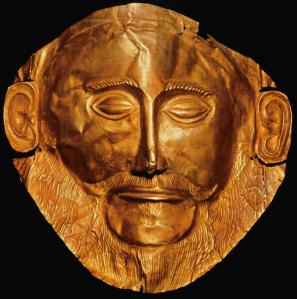 Mask of “Agamemnon” (Museum of Athens).
Mask of “Agamemnon” (Museum of Athens).
In Mycenae Schliemann discovered a series of tombs with corpses that he thought to be those of Agamemnon, Clytemnestra, Aegisthus, and other individuals from the family of Atreus. They had been buried with all their jewels mostly made with gold. The faces of these real corpses were covered with gold masks. Gold plates also covered their chests and headbands. Glasses and gold rings were also found. These graves were located within the precinct of Mycenae, in a place Schliemann called the agora* because it was surrounded by a circular bench where he supposed the council would sit to hold their assemblies. We now know that what Schliemann called agora is now recognized as the Heroon* or shrine of heroes. From the description that Pausanias made of Greece we learned that many ancient Greek cities had their heroon inside the precinct and near the city’s main door. Within the city of Mycenae Schliemann also recognized some remains of the Royal Palace with a rectangular room that was divided by columns, the megaron* (the great hall of the Greek palace complexes).
 Reconstruction of the ancient city of Mycenae.
Reconstruction of the ancient city of Mycenae.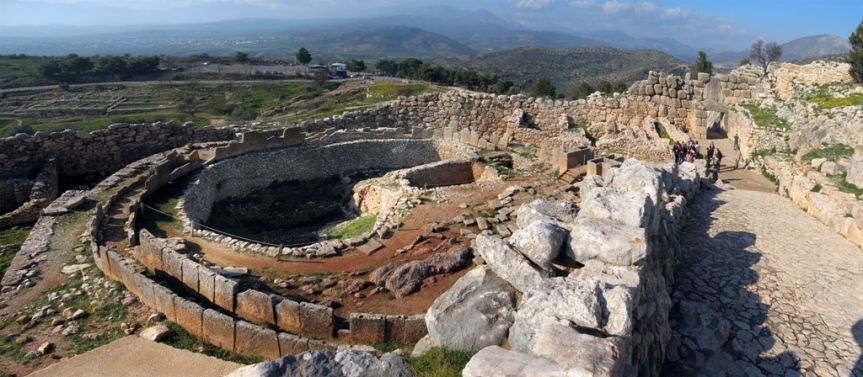 Heroon or worship place for the heroes in Mycenae (actual Greece) where the royal tombs were found.
Heroon or worship place for the heroes in Mycenae (actual Greece) where the royal tombs were found.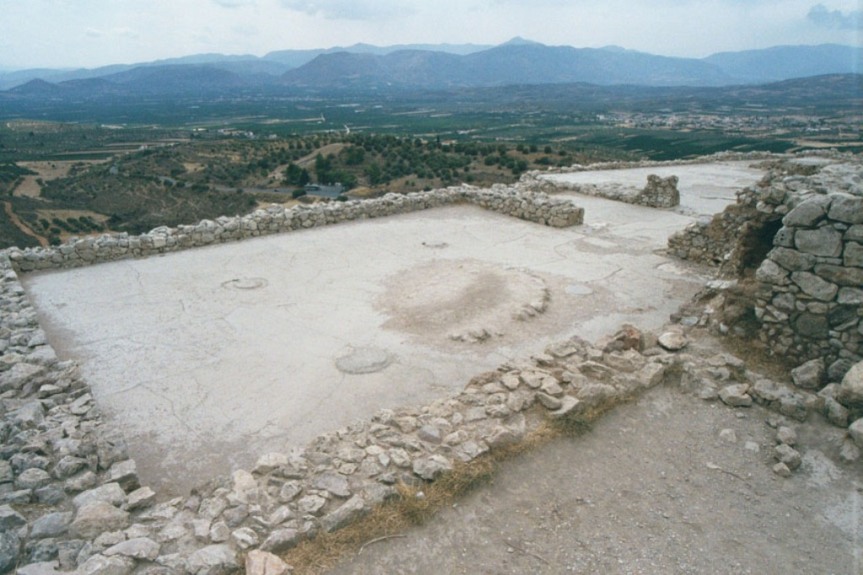 Remains of the megaron of the Royal Palace of Mycenae (Greece).
Remains of the megaron of the Royal Palace of Mycenae (Greece).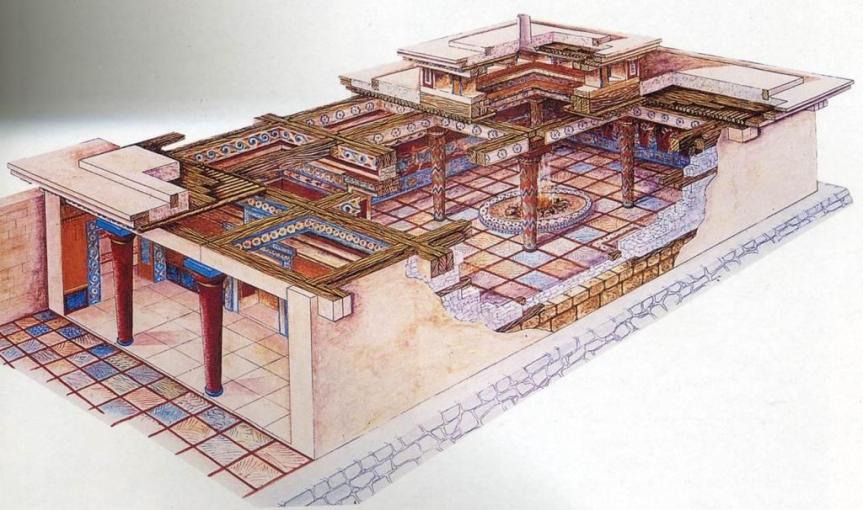 Reconstruction of the Megaron of the Royal Palace of Mycenae, a rectangular room divided by columns.
Reconstruction of the Megaron of the Royal Palace of Mycenae, a rectangular room divided by columns.

Floor plan of a “treasure” tomb type from Mycenae.
Schliemann also explored more ancient tombs called treasures, structures also mentioned by Pausanias. These buildings were outside the city walls. They were chamber-type tombs like the Prehistoric dolmens. These treasures were preceded by a hall leading to a large circular room for worship which in turn led to an adjacent small chamber that held the corpse. These vault-covered constructions were not unique, there were others alike in the area around Mycenae. Their floor plan was always circular and they were covered by flagstones that overlapped each other.
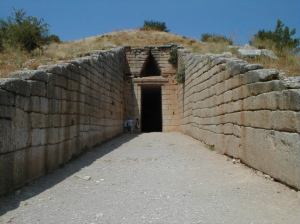
A long corridor built with large stone blocks leads to the door of the “Treasury of Atreus” in the ancient city of Mycenae (Greece). Below, two photos showing the interior of the dome structure inside the Treasury.
The most important of these tombs is known traditionally by the name of “Treasury of Atreus”. It is located on the side of a hill that rises in front of the Acropolis of Mycenae. Its dome has been preserved intact, although the triangular relief that should decorate its entry has disappeared. Its dimensions are impressive: the interior has a diameter of 14.5 mt with a maximum height exceeding 13 mt. Large blocks work as lintels to its door and what is most impressive is the regularity with which the stone blocks were cut and put in place.
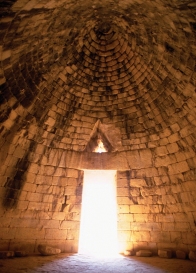
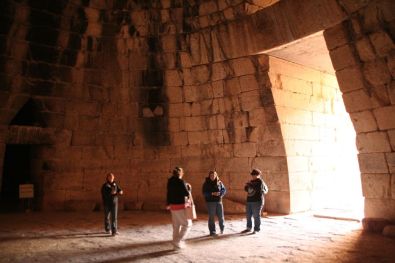
The “Lions Gate”, so called because of the triangular relief adorning it, with its walls and bastion seems to date from mid-fourteenth century BCE. It is located above the horizontal lintel of Mycenae’s door and represents two confronted lions whose heads were carved in a different stone block and that now are lost. These animals stand on either side of a pillar, exactly like those found in the palace of Knossos, and their front legs rest on the pedestal of this sacred pillar with a short frieze above its capital. Although this representation included a heraldic or sacred symbol from Crete its monumental technique is peculiarly Greek.
 The “Lions Gate”, the main entrance to the ancient city of Mycenae.
The “Lions Gate”, the main entrance to the ancient city of Mycenae. The Lion Gate of Mycenae has on the architrave the only known sculpture of the Mycenaean art. It represents two lions standing by a column, a religious symbol of Minoan origin.
The Lion Gate of Mycenae has on the architrave the only known sculpture of the Mycenaean art. It represents two lions standing by a column, a religious symbol of Minoan origin.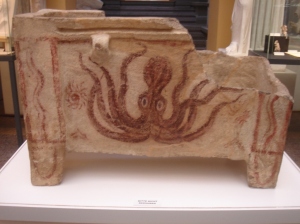 Mycenaean larnax decorated with spirals and octopi.
Mycenaean larnax decorated with spirals and octopi.
A third type of graves found outside Mycenae proves that there was a lower class population living separately on the outskirts of the city. They consisted of “boxes” made of stone or ceramic in form of small coffins called larnax* like those that were also found in all excavations of pre-Hellenic Greece archaeological sites. They were decorated with paintings or reliefs representing spirals and other geometric ornamentation. The decoration of these sarcophagi is reminiscent of the embellishments of the prehistoric Western European art (see the sun disc of the Trundholm charriot).
This is not surprising: the individuals buried in larnax or ceramic burial boxes would be the first Dorians (one of the four major Greek tribes into which the ancient Greeks were divided along with the Aeolians, Achaeans, and Ionians) that infiltrated pre-Hellenic society. The Nordic decor of their coffins is thus perfectly understandable. These three kinds of graves found in Mycenae reflect the three types of population or castes who occupied that place a century before 1,000 BCE. The monumental tombs or treasures in the form of a chamber would be those of the ancient pre-Hellenic lords, the ground level tombs of the sacred Heroon were occupied by Achaean princes that supplanted the old pure pre-Hellenic kings either by conquest or by intermarriage, and the ceramic larnax corresponded to the first Dorians perhaps stealthily infiltrated at the beginning or simply as immigrants, whose number grew as the time passed thus facilitating the military Dorian invasion and who declared being enemies of the ancient pre-Hellenic culture that otherwise was respected by the Achaeans.

Aerial view of the acropolis of Tyrins, (Greece). Reconstruction of the acropolis of Tyrins.
Reconstruction of the acropolis of Tyrins.
The fear of a rebellion or invasion is evident in the formidable fortifications of the Acropolis of Tiryns, perhaps the last defense of the Achaean lords of Mycenae. It can be reached passing the entrance to the precinct which is on the top of a vaulted hall that leads to the entrance or Propylaea with a gate on each side. After crossing a first courtyard on the north end of the acropolis it is necessary to turn at right angles and go through other propylaea to get to the main courtyard where the domestic altar and the megaron entrance were. The roof of the megaron was supported by four columns probably made of wood whose bases are still on the ground. Another similar megaron, though smaller, opened in another courtyard. The rooms for the servants were located in an extension of the fortified precinct.

“Nestor’s cup” from Mycenae (National Archaeological Museum of Athens, Greece).
In the Mycenaean civilization the decorative art offered strong elements of originality with clear Minoan influences thanks to the relationship that Mycenae established with the old Cretan culture when Mycenaeans were in contact with people from Crete circa 1,450 BCE. Certain gold cups from the Mycenaean period show that goldsmithing must have been important before Crete and Mycenae had established contact, like the artifact known as “Cup of Nestor” with two handles, and a beautifully embossed cup found in Vaphio with the figure of a running bull. Other artistic remains, however, show the importance that Minoan styles exercised in painting. Such is the case of a painting found in Tiryns representing a young woman wearing the familiar clothing used by Minoan girls and so frequently represented in Knossos.

The Vaphio Cups, ca. 1500-1450 BCE (National Archaeological Museum of Athens).
Fresco with a Woman carrying an ivory pyxis, ca. 1300–1200 BCE, found in Tiryns. This is a clear example of the influence of Cretan culture in mainland Greece. The clothing, posture, style, and rites are identical to those found in Minoan frescoes.
It is precisely in the pottery style, rather than in its ornamentation (which was here primarily figurative), where some signs of Cretan influence are observed, but its painted ornamentation shows other ambitions: they are more narrative rather than purely ornamental, and in some point reflect one of the main directions in which the classical Greek pottery ornamentation will develop in the centuries to come.

The terracotta “Warrior Krater” from late 13th century BCE found in Mycenae. It represents six warriors, each one armed with shield and spear, and wearing chiton*, short breastplate and helmet (National Archaeological Museum, Athens).
Related Post
A shocking documentary proves that mermaids do exist
SHOCKING Revelation: Thuya, Mother of Queen Tiye, Was the Grandmother of Akhenaten and Tutankhamun—What Ancient Egyptian Secrets Did She Leave Behind?
Breaking News: Astonishing Discoveries at Karahan Tepe Confirm an Extraterrestrial Civilization is Hiding on Earth, and NO ONE Knows!
Breaking News: Researchers FINALLY Discover U.S. Navy Flight 19 After 75 Years Lost in the Bermuda Triangle!
NASA’s Secret Investigation: Uncovering the Astonishing Mystery of the UFO Crash on the Mountain!
Explosive UFO Docs LEAKED: Startling Proof That Aliens Ruled Ancient Egypt!